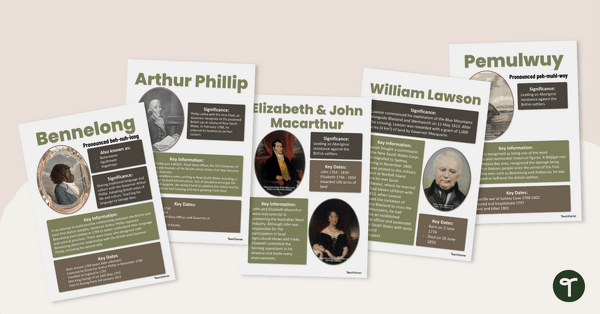Convicts Teaching Resources
Teach students about convicts in your primary school history lessons with printable worksheets, slide decks, timelines and more teaching resources designed by teachers for teachers like you.
This teaching resource collection is aligned to the Australian curriculum, and it includes printable and digital activities designed to help students better understand who the First Fleet convicts were, what a penal colony is and why these British citizens were transported to Australia.
New to teaching this portion of the Australian history curriculum? Read on for a primer from our teacher team.
What Is a Convict? A Kid-Friendly Definition
Wondering how to explain the meaning of convicts to your students? Let's start with a kid-friendly definition to share with your students.
Convicts were British people who were found guilty of committing crimes in England and were sentenced to transportation to Australia as a form of punishment.
This occurred in the late 18th and 19th centuries, when Britain had overcrowded prisons. To solve the problem, the country established penal colonies in Australia, sending thousands of convicts to Australia as both punishment and colonisation.
What Is a Penal Colony? A Kid-Friendly Definition
Another vocabulary term important for students to understand is penal colony. Here's how our teacher team explains this concept to students:
A penal colony is a type of settlement or territory established to serve as a place of punishment for criminals. In the context of Australian history, the British established several penal colonies in the late 18th and 19th centuries.
The British government chose remote locations for these colonies to prevent escape attempts. Australia became the primary destination for British penal colonies because of its distance from England and the opportunity to colonise the land.
When learning about penal colonies, it's important for students to learn about the inhumane treatment of convicts, the disruption caused to First Nations communities and the broader issues of colonialism and imperialism.
How Many Convicts Were in the First Fleet?
It's estimated that between 1788 and 1868, the British government transported about 165 000 convicts to Australia, beginning with the arrival of the First Fleet in Botany Bay in 1788.
The first and most significant British penal colony in Australia was established with the arrival of the First Fleet, which brought 775 convicts who were disembarked at Sydney Cove.
What Is a Ticket of Leave?
Convicts sent to Australia could be sentenced to a variety of punishment lengths from 7 years to 14 years or even their natural life. If a convict completed their sentence and re-offended, they would be sent to work on a chain gang, but convicts could also be reward for good behaviour with something known as a 'ticket to leave' or 'ticket of leave.'
The ticket would allow the convict more freedom to lead a normal life, including the ability to get married and raise a family.
- Plus Plan

A British Penal Colony - Teaching Slides
A 25 slide editable PowerPoint presentation to use when teaching students about the British colonisation of Australia.
- Free Plan

Life as a Convict - Journal Writing Task
A journal writing worksheet for students to complete in the classroom, or as a homework task, when learning about convicts.
- Free Plan

Convict Identification Cards - Template
A convict identification card template to use in the classroom when learning about the convicts of the First Fleet.
- Plus Plan

Significant Individuals During Colonisation/Invasion Poster Set
Explore this collection of 9 posters with your Grade 4 HASS students, when learning about impactful persons during the period of colonisation, or invasion, in Australia.
- Plus Plan

Australian Convict Life Posters
5 posters highlighting information regarding the lives of convicts in Australia.
- Plus Plan

Australian Convicts Timeline
A timeline showing the progression of convict colonisation in Australia.
- Plus Plan

Convict Life
A 60 minute lesson in which students will understand the life of a convict transported to Australia.